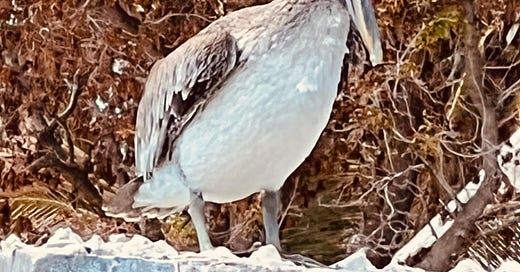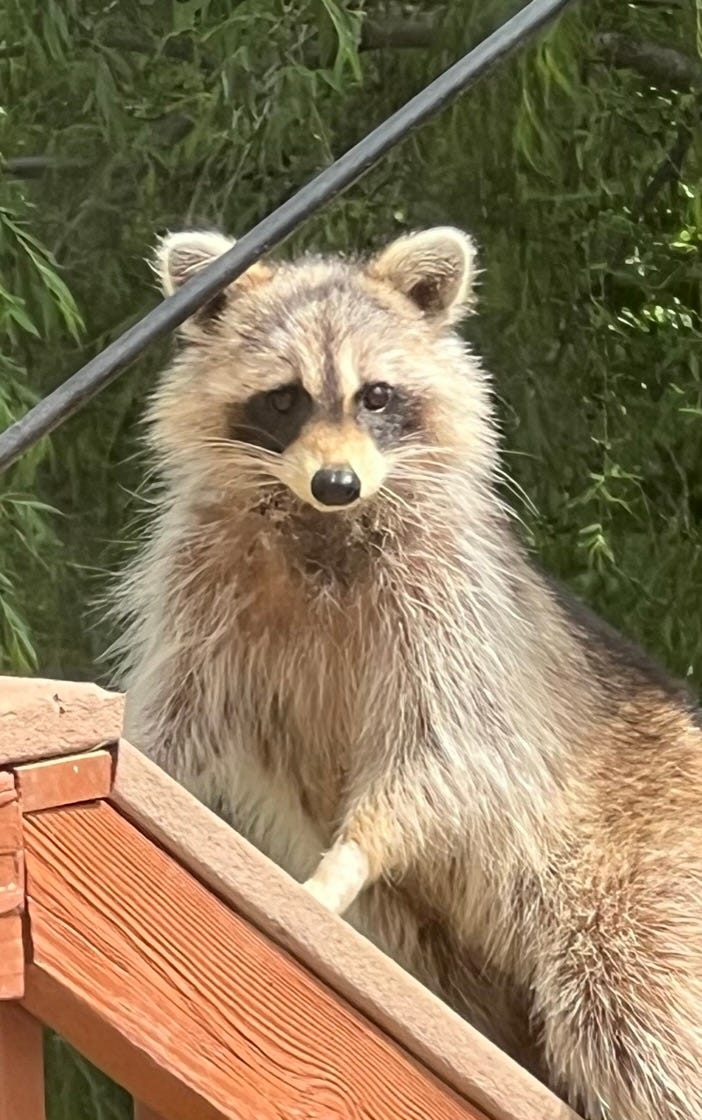You're Such an Animal
Hey, don't talk about my pelican that way! Writing with Animals and Other Human Tricks.
Brown Pelican: Key West, Florida
I’ve exciting news to share:
One of the main characters in my debut novel is a Brown Pelican named Gumbo. I write stories with science, nature, and the ocean. For this story, I knew including pelicans would be important.
Gumbo the pelican isn’t a pet, he’s a creature of nature, and he is a character. He has his own story arc, backstory, personality, and purpose.
But before I tell you about the pelican, I confess — I’m not a pet person. And while in editing school back in the 19XX’s (will not admit how long ago) I was trained that animals had no gender in writing.
The dog chewed its bone. The bird preened its feathers. It was a style rule and editors follow rules. But writers don’t follow rules and this rule should be crushed.
Follow Me Down the Research Rabbit Hole
After completing an early revision of my novel, I wanted to tell a deeper story about the environment post oil spill. I couldn’t decide which character’s POV would be strongest? I wanted readers to care about the spill and how it changed everything.
My need for a new point of view came during the pandemic, which came with some extra down time.
For many years, I’ve been a fan of Ashland Creek Press. They are a small press in Ashland Creek Oregon that publishes animal and environmental literature. They also publish Ecolit Books, an online journal.
Ashland Creek Press was running a class, Writing for Animals. I chose the self-paced course of video lectures and readings. The class changed everything for me!
Anthropomorphism
The big ah-ha came in a lesson on anthropomorphism, this refers to assigning human values and feelings to non-human animals and therefore using she/he/who.
In editing, this is a no-no and where the pronouns for animals are prescribed to be IT. However, in the real world of pet owners, dogs, cats, etc., animals are male and female. The use of gendered pronouns is allowed when there is an assumed personal relationship.
I don’t have a presumed personal relationship with the birds I feed or the critters who share my backyard. But I do care about their habitat and safety. As a writer, I have the opportunity and the responsibility to treat animals with respect in my work. We share the same space. The health and viability of that shared space is good for my health and it’s essential for theirs. The simple change of using gendered pronouns for animals in my writing has had a huge change in the range of emotion, messaging, and engagement.
The oil spill in my novel becomes more than a headline grabbing ecological disaster, it becomes personal when the life of Gumbo the pelican is threatened.
We Love Animal Stories
You may be familiar with two books that were also made into movies, The Art of Racing in the Rain by Garth Stein and Marley and Me by John Grogan. These stories feature personality-plus pets Enzo and Marely. No one considers these fur babies to be its.
Stepping back a few decades and it’s easy to see how animals and children’s stories shape our sense of the world and our first relationships. Consider classics like E.B. White, Charlotte’s Web, Margery Williams, The Velveteen Rabbit, and A.A. Milne, Winnie the Poo.
Here are some interesting sources for further reading on pronoun use and animals.
How Animals Can Enhance Stories
As people, we interact almost daily with non-humans. Your characters should as well. Consider insects, birds, farm animals, pets, and wildlife living on the edge of our urban and suburban world: squirrels, raccoons, deer, rabbits, foxes, coyotes, snakes, and bears. As we change our landscape, we change the habitat for everything. I’m not suggesting everything you write should include an animal. I’m suggesting you consider the non-human life in your stories and treat it with a heightened level of observation. Here are some of the ways I’ve used my pelican character, but it could be any animal.
Emotional connection: Writers can create deep emotional connections between readers and the characters.
Symbolism and metaphors: Animals can represent human qualities, characteristics, or ideas, and add meaning to stories.
Relatability: Animals can serve as relatable characters.
Moral lessons: Animal characters often play a role in conveying moral lessons and values. They can be used to teach lessons in children’s literature as mentioned above.
Step into nature and the environment: Animals offer a way to explore the natural world and our relationship with it.
Humor: Animals and how we react to them can lighten a story and be funny.
How Human is Too Human?
Raccoon stealing from the bird feeder, again!
Meet Rocky I, the raccoon. He’s gorgeous and along with his mate, Rocky II were living in a space underneath our backyard deck. With a ready made source of food, my beloved (ha, ha squirrel proof) bird feeder, the raccoons were feasting for days before we discovered them. As my home backs to woods, and recent road construction has caused habitat loss, I wasn’t surprised to find them on my side of the fence. I wouldn’t say they were friendly, but they weren’t overly scared of us and would throw plaintive looks like the one here when we’d step on the deck and tell them to leave. We loved watching their human-like antics and their little raccoony hands stuff seed into their faces. But, unlike the squirrels who I’ve come to accept as part of the bird crew, these larger, rabies carrying critters needed to go. We covered up their den and removed the feeder. My entire interaction will be written into my current WIP about a biologist YouTuber. But these woodland friends will not be talking.
The miracle of fiction is the use of the imagination to create characters and worlds. I personally am not ready to write an adult-level talking animal story. But that doesn’t mean it can’t happen. Here is a good article on writing talking animals.
Talking animals can also be featured in fantasy, magical realism, or fables as discussed in my last newsletter.
An animal or non-human can act in ways that a human can’t, such as climbing a wall or disappearing under a door jam to spy on an international ring of art thieves.
How you write about animals is up to you and your work. But writing with respect for them and their place in the world is a kindness the we as humans owe to the non-humans who share the planet.
You can find the books mentioned in this newsletter or any great book at my Bookshop.org affiliate link.










